Some of the best trophy elk hunting is in Idaho, Montana and Wyoming where a large population of grizzlies roam. In some units you will find only a small population of grizzlies, and the chance of running into one is slim. However, in other units the bear count is high, and you will see several during a backcountry hunt. Make sure you talk to the game warden in your unit about the regulations on bear-proofing your camp. Also, ask him where these “humpies” have been spotted. Having a few tips for hunting and living in bear country might help keep you out of harm’s way.
Tips:
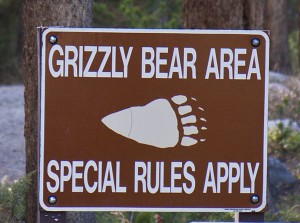
If you do have to leave an elk until the next day, some simple precautions will help to make sure your elk is still intact. First, when dressing out the bull, make sure to pull the pouch down the hill far away as possible from the elk body – the first thing some grizzlies eat is the stomach. Second, don’t quarter up the bull until you’re ready to pack it out. Bears will drag off a quarter into the brush with no problem and cover it up with dirt, but he can’t move a whole bull elk. Third, if you want to mount the bull, cape him right away, then hang the cape, skull, and antlers up high in a pine tree. Fourth, make sure to pile pine boughs over the freshly killed elk. This will help to keep ravens and other birds from getting into it.
Most importantly, when you show up the next day to pack out the elk, observe the carcass at a distance. A dead give-away that a humpy is working on the carcass is pine boughs scattered off the carcass. These precautions in packing out an elk I learned firsthand hunting in heavy grizzly country.
I recommend watching a very good DVD, Staying Safe in Bear Country. It has a lot of good information, but the best part is that you hear a grizzly doing his “I’m tougher than you” growl and watch his false charges. This will give you an idea of what an encounter with a humpy looks like. The Forest Service and Wyoming Game and Fish also have spot-on information on how to camp and hunt in grizzly country. I highly recommend those publications. My advice is to do what they recommend; it will help keep you from ending up cross-wise with a grizzly many miles from the trail head. Be safe in grizzly country!
Want more from Eastmans’? SUBSCRIBE HERE!
 Eastmans' Official Blog | Mule Deer, Antelope, Elk Hunting and Bowhunting Magazine | Eastmans' Hunting Journals
Eastmans' Official Blog | Mule Deer, Antelope, Elk Hunting and Bowhunting Magazine | Eastmans' Hunting Journals

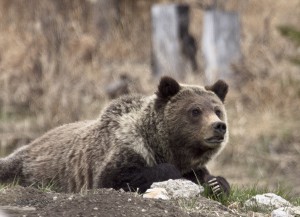
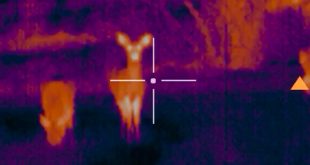
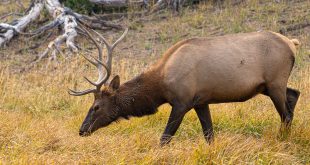

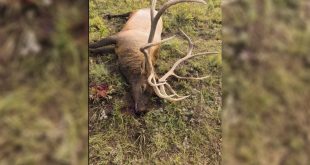

Guy, I’ve sent 2 previous emails asking for a bit of help (if you are able that is) with information on WY area 33 for cow elk (hunt 33-6) I understand that you must be busier than a one armed wallpaper hanger, I am in hopes that you might take a minute to respond to my query
I end up camping up high by myself in WY elk areas 84/85 because my hunting partners are so afraid of griz. I just keep a clean camp and cache my food 12f up, 100 down wind from camp. I’m more concerned with getting surprised while focusing on boning out an animal. Have you ever had camp ‘run-ins’ with bear? Or has it been more kill related?
BTW, we are branching out into area 92 this year due to a couple guys in the group only having dee tags and type 6 tags for 92. Any suggestions on where to focus (public land) for elk in 92? We are all rugged enough for the steeps. We are going in blind, I have never been in that area before. I hear theres a lot of elk, as the wolves haven’t really taken hold there yet. Any input wopuld be greatly appreciated.
wtf told you a grizz cant move a bull carcass? Your retarded
^I was thinking the same thing! I can almost move an elk carcass that has been gutted…
Wow you can pack out a 700 pound elk yourself? A grizzly will not move it very far but if you quarter it up he then will pack the quarters of and pad it up. Do you know what this means. You will lose you elk quarters. I live in grizzly country they come in my yard all the time. In fact a guy was killed by one near my house a couple years ago. This is how we handle meat in grizzly country of north west Wyoming.
Mike, I respect your opinion, and I don’t know about those Northwest Wyoming Grizzlies, but a mature Montana grizzly can and will move a bull elk if it wants too, I have seen a skinned and headless bull carcass ripped from a game pole and dragged 50-60 yards to thick brush where the bear fed on close to 1/3 of the meat and covered the remaining carcass with dirt, brush, and a good bit of urine. That happened, and it was only a 6′ or so bear.
One reality we need to face is that our chances of grizzly encounters is not only increasing each year, the Bears are getting more aggressive. I beleive this is caused by several factors, but mainly an increase in prey base competition from wolves and other bears. When they are pressured off of their kills by wolves or another bear, it only seems reasonable that they will become more aggressive defending territory and or food. It seems to me apex predator density has everything to do with how aggressive the bears are.
Everyone that spends time in grizzly country needs to not only be bear aware, carry pepper or lead spray(I prefer lead, pepper spray is for people) and stay on their toes, but they need a good lightweight trauma kit which includes clotting powder, clotting gauze, clotting sponges, or all 3, and plenty of med or duct tape, 2-4 ABD pads, and a decent padded absorbent tournaquit which can double as a large head bandage.
There are loads of first aid kits, and battle trauma kits available, but none are really geared toward multiple large muscle and scalp wounds like a grizzly typically inflicts. I piece milled my kit together but having a kit assembled with the right components specially for backcountry animal attack treatment would be very useful.
Blaze orange with a Eastmans logo, 10’x6’x3″, maybe 12 oz’s….. Maybe?